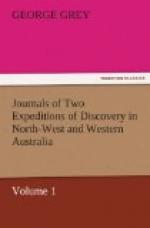Head of light red colour, mouth apparent, motion of head like a caterpillar’s when touched, shape cylindrical, body gelatinous, intestines apparent and full.
November 16. Longitude 102 degrees 40 minutes east; latitude 28 degrees 5 to 6 minutes south.
Since we have passed the 95th parallel of longitude, and 32nd of latitude up to the present moment we have been out of the region of birds, for during the whole of this period I have seen but two, one of which, a Petrel, has this moment visited us. We have however seen more Sea-jellies, Acalepha and Mollusca than before, and those of a much more beautiful kind. Thus nature has made up for the deficiency of one tribe of animals by the profuseness with which she has distributed another.
November 18. Latitude 26 degrees 57 minutes south; longitude 105 degrees 22 minutes east.
We caught a crustaceous animal (Phyllosoma, see Illustration 11) which was perfectly transparent; it was furnished with twelve legs on what I considered the hinder part of its body, and four antennae in front, which have their tips of a bright pink colour, and two eye peduncles by their side, which terminate in little bags containing some blue matter (their eyes). It was furnished also with two legs underneath. These are just shown in the figure near the centre of the body, and between those underneath the insect there was a slight projection, with two little lumps on each side. In this projecting part there appeared to be an opening. When it was taken out of the water it stood upright on its legs and crawled a little like a large beetle, but soon died. In the water it swam with the legs, and the last joint appeared to be feathered. It will be seen that there is a great irregularity in the position of the legs of this insect. The specimen appeared to me to be in some respects imperfect; but I figured it exactly as it was, without blindly guessing at its perfect state. It was not thicker than the thinnest wafer. The back was marked with curved lines, exactly in the manner I have represented. It shrank instantly when touched. The two last joints of the long legs were furnished with thorn-like spikes.
Length of tail 0.37 inches.
of the body 0.2 inches.
of the thorax and head 0.3 inches.
of the entire animal 1.4 inches.
Breadth of body 0.62 inches.
Ditto of thorax 0.51 inches.
Length of third leg 1.9 inches.
Length of second leg 1.7 inches.
Length of hindermost leg 0.6 inches.
Length of eyes, peduncles 0.4 inches.
We caught a second animal of exactly the same size as the one figured, but apparently much more perfect. Each of its tentacula terminates in a small feathering tip when it is in the water, like the little figures at the side, and by the help of which they swim; these have a horny feel to the touch, are destitute of smell, and look like a transparent scale when they lie in your hand.
We also caught this day some little transparent shells (Cuvieria) of a cylindrical form, and blunt at the end; they put out two little fins with which they swam.




